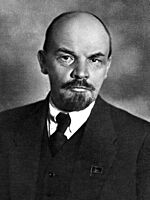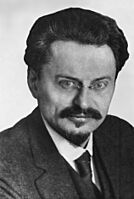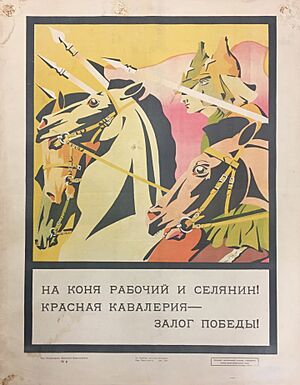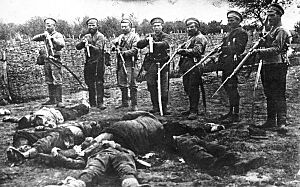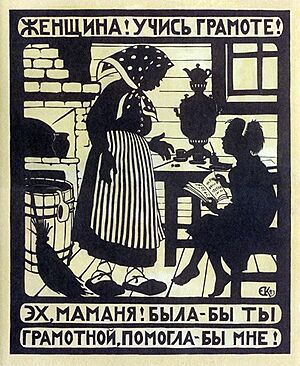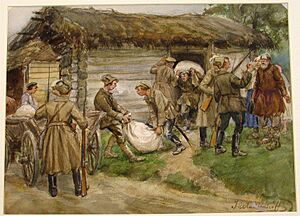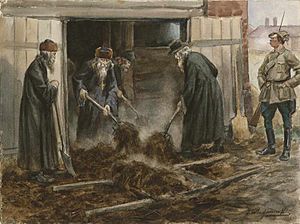History of Soviet Russia and the Soviet Union (1917–1927) facts for kids
Quick facts for kids 1917–1927 |
|
| Preceded by | Russian Empire |
|---|---|
| Including | February Revolution Revolutions of 1917–1923 |
| Followed by | History of the Soviet Union (1927–1953) |
| Leader(s) | Vladimir Lenin Joseph Stalin |
The years between 1917 and 1927 were a time of huge change in Russia. The old Russian Empire became a new socialist country called the Soviet Union. This period started with Soviet Russia from 1917 to 1922, then became the Soviet Union from 1922 to 1991.
After a big fight called the Russian Civil War (1917–1923), a group called the Bolsheviks took control. They followed ideas from Marxism, which were changed by their leader, Vladimir Lenin. This idea promised that workers would rise up, get rid of capitalism (where private businesses own things), and create a socialist society. This new society would be led by the Communist Party of the Soviet Union.
A challenge was that Russia mostly had farmers, not many factory workers (called the proletariat). There wasn't much industry or a big middle class. In 1917, the February Revolution removed Tsar Nicholas II. A temporary government took over, but then the Bolsheviks gained power in the October Revolution. The Bolshevik Party was renamed the Russian Communist Party (RCP).
The RCP didn't allow any other political ideas. They said that only their party truly represented the workers. Anyone who disagreed was seen as "against the revolution." Many wealthy families left Russia. From 1917 to 1923, the Communist Bolsheviks, led by Lenin, fought a tough Russian Civil War. They fought against many enemies, especially the White Army. They won control of central Russia but lost many non-Russian areas that used to be part of the empire.
After defeating their opponents, the RCP became strong in Russia and some other areas like Ukraine. In 1922, the Soviet Union (USSR) was formed, and the party became the Communist Party of the Soviet Union (CPSU). After Lenin's death in 1924, Joseph Stalin became the new leader. He was the General Secretary of the CPSU from the early 1930s until he died in 1953.
Contents
The Russian Revolution of 1917
During World War I, Russia faced many problems. Its army was losing, people were hungry, and the economy was falling apart. Soldiers were tired of fighting and many left the war. People were unhappy with the Tsar and his decision to keep fighting.
In March 1917, Tsar Nicholas II stepped down from power. This happened after the February Revolution, which caused big riots in Petrograd and other cities.
A temporary government, called the Russian Provisional Government, took over. It was led first by Prince Georgy Lvov, then by Alexander Kerensky. This government wanted to keep fighting in World War I with Britain and France. It also put off land reforms that the Bolsheviks wanted.
Lenin and his helper Joseph Stalin believed that working with capitalist countries was wrong. They thought Russia was going back to the old ways of the Tsar. They felt it was their job to fight these ideas and support socialist revolutions in other countries.
Soldiers were leaving the army and giving their weapons to angry factory workers. People in cities were very poor and starving. These bad conditions made it easy for revolutionaries to gain support.
Between February and October 1917, many groups questioned the Provisional Government's power. A "dual power" system appeared. The Provisional Government had official power, but the Petrograd Soviet (a council of workers and soldiers) also had a lot of influence. The Soviet was controlled by groups that were less extreme than the Bolsheviks.
Failed military attacks in the summer of 1917 and large protests in cities, known as the July Days, led to troops being sent in. But many soldiers joined the protesters instead. This made the government look weak. During this time, more people started supporting the Bolsheviks. Another important Bolshevik, Leon Trotsky, became the head of the Petrograd Soviet. This group controlled the city's military. The number of Bolshevik party members grew from 24,000 in February to 200,000 by September 1917.
On October 24, at the start of the October Revolution, the Provisional Government tried to stop the Bolsheviks. They arrested activists and destroyed pro-Communist writings. But the Bolsheviks said this was an attack on the people. They got support for the Red Guard of Petrograd to take over the Provisional Government. Government offices and buildings were taken with little fighting. The revolution is generally seen as ending when the Winter Palace was captured on October 26, 1917. This palace was a symbol of the Tsar's power.
Bolshevik leaders like Anatoly Lunacharsky and Moisei Uritsky agreed that Lenin was very important to the Bolshevik party. But they also said that the October takeover was carried out more by Trotsky's plan than Lenin's.
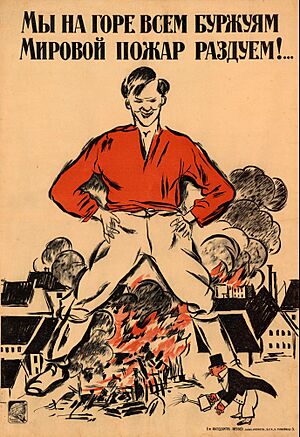
Other political groups, like the Mensheviks, left Petrograd. This left the Bolsheviks and their allies in control. On October 25, 1917, the Sovnarkom was created. It became the main government body. By January 6, 1918, the Bolsheviks supported closing down the Russian Constituent Assembly. This assembly wanted to create a non-Bolshevik government. On January 25, 1918, the new state was renamed the Russian Soviet Republic.
The Russian Civil War
Before the revolution, the Bolsheviks believed that only a strong, secret group could overthrow the government. After the revolution, they said only such a group could win against enemies at home and abroad. Fighting the civil war made them put these ideas into practice.
The Tenth Party Congress banned different groups within the party. This was meant to be a temporary rule after the Kronstadt rebellion. They wanted the party to be a small group of dedicated revolutionaries. These people would follow decisions with strict discipline. This led to loyal party members being put in charge of everything, from factories to hospitals. This system was called the nomenklatura.
In theory, this system was supposed to be democratic, with leaders chosen by members. But in practice, it was very centralized. Decisions from higher groups had to be followed by lower ones. Over time, party members became more focused on their careers. To join the party, people had to pass exams and take special courses.
In December 1917, the Cheka was formed. This was the Bolsheviks' first internal security force. It was created after an attempt to assassinate Lenin. Later, it changed names many times, eventually becoming the KGB. The Red Terror was used to remove groups seen as "enemies" of the new society. Many people were quickly executed. Leon Trotsky led the Red Army. He disliked "bourgeois democracy" and supported removing wealthy people and political opponents by force. He started labor camps and put the military in charge of workers.
At the same time, the White Terror was carried out by groups fighting the Bolsheviks. They targeted people suspected of supporting the Bolsheviks.
During the civil war, Jewish communities in Ukraine and Belarus suffered terrible attacks called pogroms. These were done by various armed groups, including parts of the White Army and even some Red Army units.
The Soviet government slowly gained control of central Russia. Then, it successfully fought its enemies. Help from other countries and the Polish invasion allowed the Bolsheviks to use national pride to gain support. However, worsening economic conditions caused big problems. After the White military forces were defeated in late 1920, there were many farmer uprisings, like the Tambov Rebellion. These were put down very harshly.
The Polish–Soviet War
After World War I, Poland became an independent country. The borders between Poland and the old Russian Empire were very messy because of the revolutions and civil war. Poland's leader, Józef Piłsudski, wanted to create a new group of East European countries. This group would protect them from Russia and Germany. Meanwhile, Soviet Russia wanted to spread the revolution westward by force.
In 1920, Piłsudski attacked Ukraine. The Red Army pushed back and almost reached Warsaw, Poland's capital. But Piłsudski stopped the Soviet advance at the Battle of Warsaw and then attacked again. The "Peace of Riga" was signed in early 1921. It divided the land of Belarus and Ukraine between Poland and Soviet Russia.
Creating the USSR
On December 29, 1922, leaders from different Soviet republics met. These were the Russian SFSR, the Transcaucasian SFSR, the Ukrainian SSR, and the Byelorussian SSR. They agreed to the Treaty on the Creation of the USSR and the Declaration of the Creation of the USSR. These documents officially formed the Union of Soviet Socialist Republics (USSR).
These documents were confirmed by the first Congress of Soviets of the USSR. They were signed by the heads of the groups on December 30, 1922. These leaders included Mikhail Kalinin, Mikhail Tskhakaya, Mikhail Frunze, Grigory Petrovsky, and Alexander Chervyakov.
Propaganda and Media
Many of the Bolshevik leaders who came to power in 1917 were writers or editors. This included Lenin, Trotsky, and Stalin. Lenin started the newspaper Pravda in 1912. It was very good at spreading Bolshevik ideas. After 1917, the Bolsheviks (Communists) controlled all media. The main national newspapers were Izvestia (the government's voice) and Pravda (the party's voice). Pravda had the best printing equipment for pictures. These newspapers used special language to support the government.
The Communist leaders used printed materials to spread their message. Most people in Russia couldn't read. So, they made schools and literacy a high priority. This helped more people read newspapers and magazines. Posters were also used to reach older people who couldn't read.
The Likbez campaign (meaning "getting rid of illiteracy") started on December 26, 1919. Vladimir Lenin signed a law that said everyone from 8 to 50 years old had to learn to read and write in their own language. About 40,000 special centers were set up for education. During the Russian Civil War, the Soviet Ministry of Education quickly formed a group to train teachers and organize the literacy campaign.
Radio was also important. It was a new technology used for political speeches. The Soviet government didn't like private radio operators. So, instead of broadcasting over the air, radio programs were sent through wires to loudspeakers. These loudspeakers were in approved places, like factories.
The Soviet way was for citizens to listen to party leaders. This happened through speeches, radio talks, or printed speeches. Journalists didn't summarize or explain the news. No one questioned the leaders. There were no press conferences or much news broadcasting.
Foreign reporters were not allowed to talk to anyone except official spokespeople. This led to a very positive picture of Soviet life being shown in Western media.
War Communism
During the Civil War (1917–1921), the Bolsheviks used a policy called War communism. This meant breaking up large land estates and taking extra farm products by force. In cities, there was a big shortage of food, and the money system broke down. Many city people moved to the countryside to farm the land that had been given to peasants. Even small private businesses were stopped.
The Kronstadt rebellion showed that War Communism was not popular with farmers. In March 1921, after the civil war, sailors who were mostly farmers rebelled. They were unhappy with the new government's economic failures. The Red Army, led by Lev Trotsky, quickly stopped the rebellion. This growing unhappiness made the party realize it needed to work with both workers and farmers (who made up 80% of the population).
Millions of people died from starvation. Communist officials were unsure what to do about the Russian famine of 1921–22. Food was bought from other countries, but it only went to cities, not to the farmers. Eventually, Herbert Hoover offered food and medicine from America. This help fed up to 11 million people. Other groups also helped feed millions more.
New Economic Policy
At the Tenth Party Congress, the Bolsheviks decided to end War Communism. They started the New Economic Policy (NEP). This policy allowed some private businesses and a limited market. Rules on political activity were also relaxed a bit.
The biggest change was for farmers. Instead of taking their extra farm products by force, the NEP allowed farmers to sell their extra goods in the open market. However, the government still controlled the most important parts of the economy. These included heavy industry like coal, iron, and metal factories, as well as banks. These "commanding heights" employed most of the workers in cities. Under the NEP, these state industries could make many of their own economic decisions.
During the NEP, there was a big increase in trade by merchants. These merchants were often called "speculators" by some Communists. But the growth in trade generally meant better living standards for people in both cities and the countryside. About 80% of Soviet citizens lived in the countryside at this time.
Factories were damaged by the civil war and were not producing much. Also, factories were grouped into large trusts, which caused problems with supply and demand. Without competition, these trusts often sold their products at higher prices.
The slow recovery of industry caused problems for farmers. Since farming was more productive, industrial goods cost more compared to farm products. This was called the "Scissors Crisis" by Trotsky because of how the prices looked on a graph. It meant farmers had to produce more grain to buy goods from the cities. Some farmers held back their products, hoping for higher prices, which led to small shortages in cities. Many Communists didn't like this market behavior.
To fix the crisis, the party tried to lower prices for manufactured goods. They also tried to break up the large trusts to make the economy more efficient.
Lenin's Death and the NEP's Future
After Lenin had a third stroke, a group of three leaders took charge. These were Joseph Stalin, Grigory Zinoviev, and Lev Kamenev. They led the Communist Party of the Soviet Union and the country. They also tried to stop Trotsky from gaining power. However, Lenin became worried about Stalin. After his stroke in December 1922, Lenin wrote a letter (known as Lenin's Testament). In it, he criticized Stalin and suggested he be removed as General Secretary. This job was becoming very powerful. Stalin knew about Lenin's letter. He tried to keep Lenin isolated and increased his own control over the party.
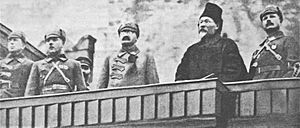
Zinoviev and Nikolai Bukharin became concerned about Stalin's growing power. They suggested that Stalin's office be removed. They also wanted Zinoviev and Trotsky to join the party's main office, which would lessen Stalin's power. Stalin reacted strongly. His office stayed, but Bukharin, Trotsky, and Zinoviev were added to it.
Because of growing political differences with Trotsky, the group of Stalin, Zinoviev, and Kamenev reunited in late 1923. At the Twelfth Party Congress in 1923, Trotsky did not use Lenin's Testament against Stalin. He was afraid it would make the party unstable.
Lenin died in January 1924. In May, his Testament was read to the Central Committee. But Zinoviev and Kamenev said Lenin's concerns were wrong and that Stalin should stay General Secretary. The Central Committee decided not to publish the testament.
Meanwhile, the campaign against Trotsky grew stronger. He was removed from his job as People's Commissar of War that year. In 1925, Trotsky was criticized for his essay Lessons of October. This essay criticized Zinoviev and Kamenev for not supporting Lenin's plans in 1917. Trotsky was also criticized for his idea of permanent revolution. This idea said that socialism needed a worldwide revolution. Stalin believed that socialism could be built in Russia alone. As the chances of revolution in Europe faded, Trotsky's ideas seemed less hopeful for Russian socialism.
In 1925, the Soviet Union took over the island of Urtatagai. This island was considered Afghan territory. It was used by a group called the Basmachi movement to start border raids. In 1926, the Soviet Union left the island after Afghanistan agreed to control the Basmachi.
After Trotsky resigned, the unity of the three leaders began to break apart. Zinoviev and Kamenev again worried about Stalin's power. Stalin then formed an alliance with Bukharin and his supporters. This group supported the New Economic Policy. They wanted to slow down industrialization and encourage farmers to produce more by using market incentives. Zinoviev and Kamenev criticized this policy, saying it was a return to capitalism.
The conflict exploded at the Fourteenth Party Congress in December 1925. Zinoviev and Kamenev protested against Stalin's harsh policies. They tried to bring up Lenin's Testament again, which they had hidden before. Stalin used Trotsky's earlier criticisms of Zinoviev and Kamenev to defeat them. He brought in his own allies like Vyacheslav Molotov and Kliment Voroshilov. Trotsky was completely removed from the politburo in 1926. At this Congress, Stalin also began to be called "leader" and praised a lot. This was the start of Stalin's cult of personality.
Trotsky, Zinoviev, and Kamenev formed a group called the United Opposition against Stalin and Bukharin. But they had lost influence. In October 1927, Trotsky, Zinoviev, and Kamenev were kicked out of the Central Committee. In November, before the Fifteenth Party Congress, Trotsky and Zinoviev were expelled from the Communist Party itself. Stalin wanted to stop them from making their fight public. By the time the Congress met in December 1927, Zinoviev had given in to Stalin. He said his past opposition was "anti-Leninist." The few remaining members loyal to the opposition were insulted. By early 1928, Trotsky and other leaders of the opposition were sent away from the main cities.
Stalin then turned against Bukharin. He used Trotsky's old criticisms of Bukharin's policies. Stalin promoted a new plan that favored collecting farms into large groups and fast industrial growth. This forced Bukharin and his supporters into the Right Opposition.
At a Central Committee meeting in July 1928, Bukharin and his supporters argued that Stalin's new policies would cause problems with farmers. Bukharin also mentioned Lenin's Testament. While he had support in Moscow and from some government leaders, Stalin's control of the party's main office was key. It allowed Stalin to control elections for party jobs across the country. This gave him control over a large part of the Central Committee. The Right Opposition was defeated. Bukharin tried to join forces with Kamenev and Zinoviev again, but it was too late.
Nationalities

The Russian Empire had many different groups of people, languages, and religions. The idea of nationalism, which was strong in Europe in the 1800s, was also important in Russia, Ukraine, and Finland. Later, nationalism appeared in Central Asia, especially among Muslim people.
The Bolsheviks used the idea of "Self-determination" to fight against imperialism and gain support from non-Russian groups. Lenin believed that after the revolution, all groups would be free to choose. They could either join Soviet Russia or become independent. Some Bolsheviks thought nationalism was less important than class conflict and would disappear with socialism.
Lenin's ideas won, and Stalin supported them. Stalin became the party's expert on different nationalities. The "Declaration of the Rights of the Peoples of Russia" in November 1917 said the new Soviet state had no fixed borders. It invited other nations to join. The "Declaration of the Rights of the Toiling and Exploited People" in January 1918 said all groups would have the right to decide how they would be part of the new federal government.
A new agency was created called the People's Commissariat for Nationalities (NARKOMNATS). It was based in Moscow and operated from 1918 to 1924. It was responsible for 22% of the Soviet population. Stalin led it. It settled border disputes and set up special regions for non-Russian peoples. It also started newspapers in local languages and helped people learn to read. It had a caring approach to "backward" or "primitive peoples." Soviet experts studied these groups. There were special groups for Jewish people (Evkom) and Muslim people (Muskom).
See also
 In Spanish: Historia de la Rusia Soviética y la URSS (1917-1927) para niños
In Spanish: Historia de la Rusia Soviética y la URSS (1917-1927) para niños
- Foreign relations of the Soviet Union
- History of Russia
- Timeline of Russian history
- Historiography in the Soviet Union
- Leninism
- Politics of the Soviet Union
- Political repression in the Soviet Union


